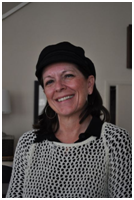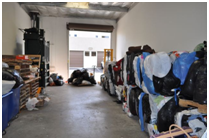
By Sharon Ann Hamilton
February 16, 2014 (San Diego)--What would you do if you realized that in San Diego County alone, about 225,500,000 pounds of textiles are purchased every year and only 15% are resold, repurposed, or recycled? Fully 85% end up in landfills.
If you believed with all your heart that you could make a difference, what would you do?
A forward-thinking woman named Benita Webber is taking action by building a textile collection company. She calls it “Ripple Textile Recycling”. Ripple Textile offers textile collection services to not-for-profit organizations such as schools, churches, Scouts, service clubs and Parent Teachers Association (PTA) groups as individuals and corporations. She is committed to sharing her revenue in a fair way with the organizations that offer this fundraising opportunity.
She also speaks of her determination to build her company and offer fair living wages to her employees, not just the bare minimum that the law requires. She is proving that you can live green and prosper.
A former educator and at-home mom, Benita and her husband, Jeff, decided on a lifestyle change when their children were grown. The time had come and she began finding her quest. Her search led her to information and statistics about the vast amount of textiles that end up in landfills – 6% across the country. They moved from the Midwest to Portland, Oregon. They sold their cars and used public transportation and walked to stores and restaurants. She saw a need.
The idea of finding a green way to make money percolated and in December of 2011, after a move to San Diego, she met with SCORE [Senior Core of Retired Executives] on how to create this business. She learned about a Mira Costa College Small Business Development Center and met with a business advisor who helped her put a plan together. Then she took action and launched Ripple Textile.
Recycling is not a new idea. The first professional garment recyclers date back to the 1600s. They took bits and pieces of old clothing to grind up and reuse. Today, on a schedule, Benita drives a truck and picks up what has been collected. Drives are organized by various PTAs in the county, and referrals to other not-for-profit organizations create a ripple of donations that all work at reducing landfill while earning money. Most of us already know about donating clothing, but we can also bring stuffed animals, pet beds, clipping bags, yarn, suitcases, uniforms, linens, drapes, cushions, comforters, craft projects, and costumes.
These textiles are repurposed, converted or recycled in ways that benefit the world. Wearable and usable clothing and textiles are sold, providing affordable used clothing to people who cannot afford new, to refugees and to victims of natural disasters. Non-wearable but useable textiles are made into rags or industrial wiping cloths, offering alternatives to single use paper products currently used. Non-wearable and non-useable items are sorted into natural, synthetic and blend fibers. To make new garments, the natural fibers are converted back into a fiber by spinning into new threads and yarns to make new garments, The synthetics and blends will be ground up and made into woven, knitted or non-woven articles. Some of these are stuffed animals, pet beds, household items, low-end blankets, carpet backing and padding, upholstery, building materials like insulation, automobile carpeting, sound absorption, speaker cones, even US currency and high end paper.
The textile business is a global endeavor. The primary phases are gathering, processing, manufacturing, and shipping. In the gathering stage people sell items to Ripple Textile Recycling for a cause, or thrift stores. When sold through Ripple, the items are left unsorted, bailed and sold to a processor. Ripple supports US based needs and businesses. When donated to a thrift store, on average 34% of the items end up in the store for 30 days. They are then bailed with the remainder to be sent to either manufacturing facilities or overseas. The sheer logistics of shipping is staggering.
Many of the containers on trucks and ships are full of textiles bound for foreign manufacturing plants. The scary thing about foreign plants is the lack of oversight of safety and working conditions. Are slaves being used? It is a compelling reason to keep the business in the US.
One answer to reducing the quantity of textile consumption is to educate people about buying less, buying better quality and keeping clothing longer. The average American buys seven garments and 1 pair of shoes each month. For a family of four, it adds up to nearly 40 garments each month if you add in belts and scarves. We are buyers. Just imagine adding 40 garments each month into your home for a year. That equals nearly 500 garments each year and if you did not remove some of them, in ten years you would have over 2000 garments. We need help!
Interestingly enough, there is a trend toward purchasing gently used clothing. Both Goodwill and the Salvation Army recently sponsored fashion shows in San Diego to raise money for their causes. Models [employees] strutted down the runway wearing items and accessories that had been donated and amazed attendees with the delightful and modern possibilities awaiting discovery in the nearest store. In fact, Goodwill recently opened a store on Girard Street in La Jolla and it is proving to be a success. Imagine name brands, hardly worn, for just a few dollars.
Another answer to the massive textile recycling challenge is to learn to be happy with less. Many may not have the choice. There are 70 million baby boomers retiring in the next decade, most with inadequate savings. It may be that financial stresses send the entire generation of baby boomers into a mode of consuming far less than they ever have.
In the quest of her own repurposed life, Benita Webber has three major lessons that she would share with others.
Lesson 1: Follow your Passion. Benita wants to make an ever-expanding difference in her world and will do it using Ripple Textiles, sharing proceeds with collecting organization, and educating everyone she can.
Lesson 2: Be Patient. It takes time to build a business. The research and planning must be thorough. Sometimes others will want to horn in but stay strong and focused.
Lesson 3: Being in the Right Place at the Right Time is key. Networking is a vital need for business building.
Just as we learn about how to be fit and healthy, or how to better manage our finances, we can learn to be thoughtful consumers and recyclers beyond the blue trashcans at the curb. Each of us could choose to be a collection point and accumulate items until there is enough to use the free shipping offer. We also can continue to educate ourselves and learn greener habits. Here are a few resources for your information:
http://www.terracycle.com/en-US/
http://www.epa.gov/osw/conserve/materials/textiles.htm
Once you understand Benita’s message; live green and prosper, you might decide to find your own way along this path and your life will never be the same.
SharonAnn Hamilton is The Retirement Concierge and works with clients who want to preserve the wisdom of their families through writing and publishing stories among other services. www.yournextrordinarylife.com







Recent comments